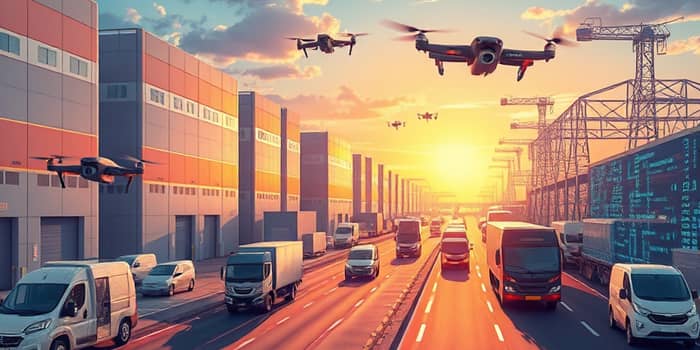The global e-commerce logistics market has undergone a remarkable transformation over the past decade. From its modest beginnings to its current status as a cornerstone of the digital economy, each stage has been marked by technological advances, shifting consumer expectations, and massive capital deployment. Today, with the market valued at approximately $524.2 billion in 2024 and projected to soar to $5,340.2 billion by 2034, we stand firmly in the rapid expansion phase—a period defined by aggressive investment, technological disruption, and unprecedented scale.
Understanding the Market Lifecycle
Every industry follows a familiar lifecycle: introduction, growth, maturity, and eventual saturation. The e-commerce logistics sector is no exception:
- Introduction Phase: Early infrastructure build-out, basic fulfillment services, and experimental technology pilots.
- Growth Phase: Explosive revenue gains, widespread adoption of automation and digital platforms, and rapid network expansion.
- Maturity Phase: Slower but steady growth, industry consolidation, optimization of existing assets, and incremental innovation.
- Saturation Phase: Market reaches capacity, competition peaks, and pricing pressures intensify.
Based on key metrics—double-digit annual growth, surging investments, and widespread adoption of advanced technologies—the e-commerce logistics market is squarely in its growth phase. This is the moment when bold players seize market share by building new capacity, rolling out cutting-edge systems, and scaling operations globally.
Evidence of the Growth Phase
The following data points underscore the vitality and momentum of this growth period:
- High CAGR Figures: A projected 26.4% compound annual growth rate for 2025–2034, driving market size from $524.2 billion to over $5.3 trillion.
- Surging Warehouse Investments: E-commerce warehousing valuations climbing from $209.2 billion in 2024 to $576.5 billion by 2030—an indicator of aggressive capacity expansion.
- Digital Logistics Boom: The digital logistics segment jumping from $37.64 billion in 2025 to an expected $120.33 billion by 2032, reflecting widespread digitization efforts.
- Widespread AI Adoption: 80% of logistics companies deploying AI tools in 2025, achieving up to 50% faster fulfillment and 15% cost savings.
Together, these figures paint a clear picture: the industry is unlocking new efficiencies and scaling at a feverish pace, hallmarks of the robust growth phase.
Key Drivers Accelerating This Phase
A confluence of factors is fueling this expansion:
- Consumer Demand: Expectations for same-day and next-day delivery push logistics networks to expand footprints and enhance last-mile capabilities.
- Cross-Border Commerce: Rising international online sales demand integrated customs solutions and bonded warehousing to keep goods moving seamlessly.
- Technological Disruption: Automation, robotics, IoT, and AI revolutionize forecasting, real-time tracking, and routing, making operations faster and more reliable.
- Sustainability Pressures: Green warehousing, electric fleets, and renewable energy initiatives attract investment as companies aim to reduce carbon footprints.
Regional Highlights of Expansion
Different markets epitomize the growth phase in unique ways:
These regional success stories illustrate how the growth phase is being played out on the ground—whether through cutting-edge technology trials or vast new facility construction.
Challenges on the Growth Trajectory
Even in a turbocharged expansion phase, obstacles remain:
- Infrastructure Gaps: Emerging markets struggle to keep pace, creating bottlenecks that hamper growth.
- Geopolitical Risks: Tariffs, trade tensions, and regulatory shifts can disrupt established supply corridors.
- Environmental Mandates: Stricter emissions rules require fresh capital outlays for greener fleets and facilities.
- Financing Costs: Elevated interest rates may slow down certain high-cost infrastructure projects.
Addressing these challenges will be crucial to sustaining the current momentum and avoiding flattening growth curves prematurely.
The Road Ahead: From Growth to Maturity
Looking forward, companies that thrive will be those that:
- Invest strategically in scalable automation and AI.
- Forge resilient cross-border networks with integrated customs and multi-modal transport.
- Pioneer sustainable practices to meet evolving regulations and consumer values.
- Leverage data analytics for continuous process optimization.
As the sector approaches its maturity phase—projected over the next decade—growth rates will moderate. Leaders will shift focus toward optimizing existing assets, refining service levels, and driving incremental innovation.
For now, however, the e-commerce logistics market remains in its most dynamic chapter: a period of rapid expansion that promises to reshape global commerce. Stakeholders who grasp this moment—deploying capital wisely, adopting breakthrough technologies, and navigating challenges adeptly—will set the stage for sustained success in the years to come.














